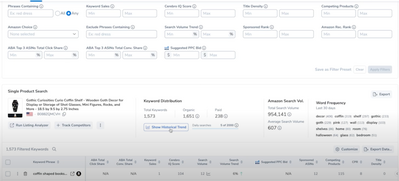Let's talk about you can view the history of how many keywords a product has ranked for organically or in sponsored ads.
Why? Well because as sellers, tracking the historical keyword ranking of a product can help us understand seasonal trends, competitor ad strategies, and overall ranking patterns.
With Helium 10’s historical trends feature, you can see how many keywords a product has ranked for organically and in sponsored ads over time. Did you know you can then use this insight to adjust your PPC and organic strategies to capitalize on market shifts and outperform competitors?
Here's how.
Open up a multi-ASIN search inside of Cerebro. Typically, the tool shows you current keyword rankings --- aka what’s happening now. BUT clicking Show Historical Trend will give you a time machine view of past rankings.
This is particularly useful for seasonal products, where search behavior fluctuates. For example, a beach ball in December will rank for different keywords than in June and July letting you do an array of things like forecast, optimize keyword targeting and more.
To view this data, go to Cerebro and find the “Show Trend” button under Keyword Distribution. Clicking this opens a historical chart showing up to two years of keyword ranking data for both organic and sponsored listings. The data is color-coded, showing how rankings fluctuate over time. For instance, if a competitor ranked for 698 organic keywords and 281 sponsored keywords in October, but then dramatically increased their PPC spend in November and December, you can anticipate similar behavior this year and adjust your strategy accordingly.
How Can This Make You Money?
Well -- by analyzing competitors' past PPC and organic ranking trends, you can make informed decisions on when to increase or decrease ad spend. If a competitor reduces their PPC in January, this might be an opportunity to increase your bids and capture market share. Alternatively, if they ramp up spending in November and December, you may decide to either compete aggressively or focus on alternative keywords to avoid high costs.
This data also reveals how competitors grow sales—whether through expanding keyword coverage or refining their focus on high-converting terms. If their sales increase while the number of keywords decreases, it suggests they are focusing on a few highly effective keywords. Identifying these can help you optimize your own strategy.
Go try this for yourself and let me know in the comments what you discover!


